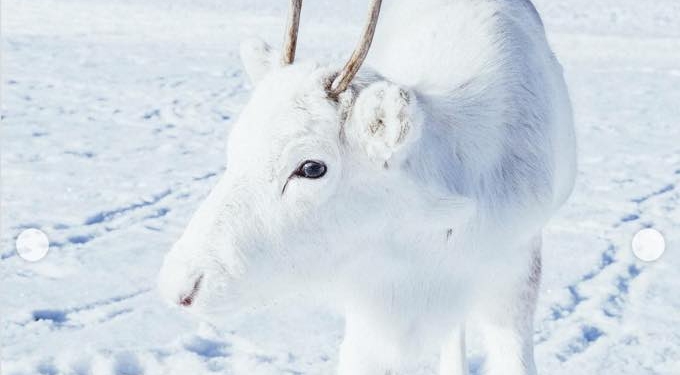
By Jade Small | Creative Commons | TheMindUnleashed.com
(TMU) — If it's a snowy wonderland you’re after, the Nordics in winter are indeed spectacular and blessed with magnificent scenery. And if you’re lucky, you might spot some interesting and sometimes rare wildlife.
During a hike near Oslo in Norway, wildlife enthusiast photographer Mads Nordsveen was fortunate to have an unusual experience with a rare animal two winters ago.
Nordsveen explained:
“I was walking in the mountains looking for nice landscapes for my travel photography when out of nowhere I saw this adorable animal.”
The adorable animal happened to be a very well camouflaged baby deer, as white as the snow surrounding it. According to Nordsveen, it made no attempt to hide and even seemed to pose for some pictures.
It seems both Nordsveen and little deer were surprised and curious about the strange creature they encountered.
The photographer was also delighted to meet the little one:
“He came very close to me, and we looked at each other straight in the eyes,” he recalled, “After some minutes the mother of the white deer came out of trees just behind. It walked around for some minutes before running back to its mother. It was very magical and a fairy tale moment.”
People have been captivated by white deer, probably since the first one was spotted likely millennia ago. These mysterious, ghostly creatures were featured in folklore, myths, and superstition and are considered to be sacred.
One persistent legend warns that a hunter killing a white deer will have bad luck for a long time and this idea appears to be universal among hunting cultures. In his book, Kudu, writer Peter Flack notes that hunters across Africa believe misfortune, perhaps even death, will befall any hunter who kills a white antelope, while those who see the mysterious white deer would be blessed with luck.
https://www.instagram.com/p/Bq7S3wIh96s/?utm_source=ig_embed
According to Dr. Nicholas Tyler, from the Centre for Saami Studies at the University of Tromso in Norway, white reindeer are rare but easy to spot in summer, when most photographs of them are taken. While white reindeer have an uncommon genetic mutation that strips their fur of pigment giving them great camouflage in the snow, they have dark pigmentation in their eyes and antlers and as such are not classified as albinos.
On the other hand, Jerry Haigh, a professor of Large Animal Clinical Sciences at the University of Saskatchewan, Canada has spent time studying the reindeer herds of Northern Mongolia. Haigh discovered that white reindeer is ‘’quite common’’ in the herds cared for by the nomadic Dukha community.
In recent years, with advanced technology enabling surveillance in areas difficult to access, more examples of wild species’ babies born without pigment have been found, although many seldom survive in the wild due to either being an easy target for predators or being rejected by the mother or herd.
One animal being born with white fur in a species whose fur is usually not white is often incorrectly referred to as albino when they likely have a different condition.
















